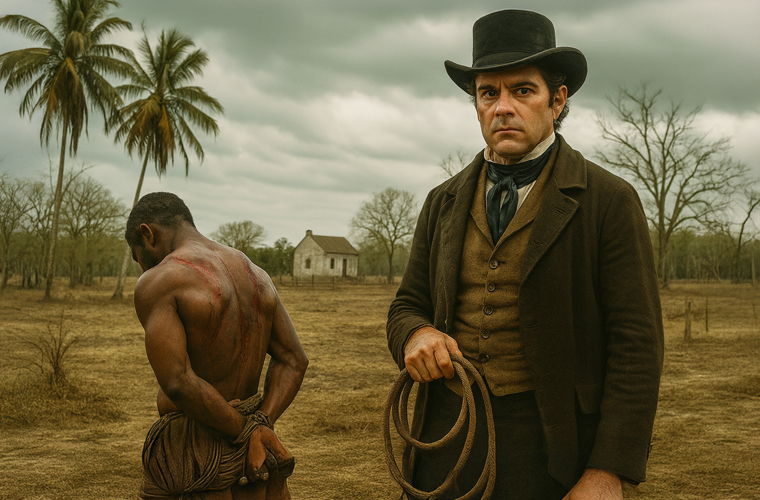The Tyrant of the “Farm of Death”
In the annals of colonial history, few figures embody the brutal excesses of slavery like Arthur William Hodge. A British planter in the British Virgin Islands, Hodge transformed his Bellevue plantation on Tortola into a site of unimaginable horror, earning it the grim moniker “The Farm of Death” in modern retellings. Between 1803 and 1811, Hodge’s regime of terror claimed the lives of dozens—if not hundreds—of enslaved people through torture, flogging, and deliberate murder. His methods included scalding slaves alive with boiling liquids, a practice that shocked even the hardened sensibilities of the era. Hodge’s conviction and execution in 1811 marked a rare instance of accountability in the slave-owning British Empire, making him the first white man hanged for the murder of a slave. This article explores his life, the atrocities on his plantation, and the trial that ended his reign of cruelty.
Arthur William Hodge was born around 1763 in the British Virgin Islands, the son of a prominent planter. He received a privileged education, matriculating at Oriel College, Oxford, in December 1781. Briefly, he served as a second lieutenant in the 23rd Regiment of Foot, commissioned on December 3, 1782, before returning to the Caribbean to manage family interests. Upon his father’s death in 1803, Hodge inherited the Bellevue plantation on Tortola, a remote and mountainous estate far from prying colonial eyes. What began as a sugar cane operation soon devolved into a personal fiefdom of sadism, where Hodge exercised absolute power over the enslaved Africans forced to labor there.
Hodge’s marriage to Ann Hoggins further entrenched him in planter society, but his temperament was already notorious. Witnesses later described him as a man driven by rage and entitlement, viewing slaves not as human beings but as disposable property. By the early 1800s, Bellevue had become synonymous with death, a reputation that spread through whispered tales among the islands’ enslaved communities.
The Plantation of Horrors: Bellevue as “The Farm of Death”
Bellevue plantation, isolated in Tortola’s rugged terrain, provided the perfect backdrop for Hodge’s unchecked brutality. Modern accounts have dubbed it “The Farm of Death,” a fitting epithet for a place where human life was extinguished with chilling regularity. According to trial testimony, at least 60 slaves were buried on the estate in just three years, with only one dying of natural causes. By 1808, when Hodge’s wife died, so few slaves remained that there weren’t enough able-bodied workers to dig her grave—a stark testament to the plantation’s mortality rate.
Hodge’s tortures were methodical and varied, designed to instill terror and extract maximum suffering. Floggings were routine, often continuing until the victim succumbed. Slaves like Jupiter, Tom Boiler, and Simon were whipped to death for minor infractions. Others, including Welcome, Gift, and Violet, met similar fates. Even free Black individuals, such as Peter, were allegedly flogged to death on Hodge’s orders.
Children were not spared. Hodge fathered several mulatto children with enslaved women and subjected them to horrific abuse. He flogged his eight-year-old daughter, Bella, and repeatedly held the heads of other mulatto children underwater until they lost consciousness, reviving them only to repeat the process.
Scalding Alive: The Pinnacle of Cruelty
Among Hodge’s most infamous methods was scalding slaves with boiling liquids, a form of torture that literally burned victims from the inside out or peeled their skin away. Two enslaved women, cook Margaret and washerwoman Else, died after boiling water was poured down their throats—a slow, agonizing death that exemplified Hodge’s sadism. In another case, a ten-year-old boy named Sampson was dipped into boiling liquor until his skin peeled off, leaving him to suffer fatally from his injuries. These acts were not isolated; they formed part of a pattern where Hodge used heat and fire to punish and kill, turning everyday plantation resources into instruments of death. Survivors recounted how these scaldings were performed publicly to deter resistance, with victims’ screams echoing across the fields. Hodge’s isolation on Tortola allowed such horrors to persist unchecked for years, as colonial authorities rarely intervened in planter affairs.
The Murder of Prosper and the Trial
The case that finally brought Hodge to justice centered on the murder of a slave named Prosper in October 1807. Prosper was accused of allowing a mango to fall from a tree, for which Hodge demanded six shillings—a sum the enslaved man could not afford. When Prosper borrowed only three shillings from another slave, Hodge ordered him flogged mercilessly on October 2 and again the next day, tied to a tree until he could no longer cry out. Prosper died on October 15 from his wounds. Indicted on March 11, 1811, Hodge fled but was captured. His trial began on April 25, 1811, with damning testimony from witnesses like overseer Stephen McKeough, enslaved woman Perreen Georges, and Justice of the Peace Daniel Ross. Georges described the flogging in graphic detail: “He was licked so long that his head fell back, and he could not bawl out any longer.” Hodge’s defense attempted to discredit witnesses but failed. In his statement, he admitted guilt toward many slaves but denied murdering Prosper, claiming, “I call God to witness to my innocence in respect to the murder of Prosper.” The jury convicted him on April 30, and Chief Justice Richard Hetherington sentenced him to hang, emphasizing that “the law makes no distinction between master and servant.”
Execution and Legacy
On May 8, 1811, Hodge was hanged near Tortola Prison, with Governor Hugh Elliot—an abolitionist—imposing martial law to prevent unrest. His execution sent ripples through the British Empire, highlighting the moral rot of slavery and fueling abolitionist movements. Today, Hodge’s story is recounted in films, videos, and historical narratives as a cautionary tale of unchecked power. “The Farm of Death” stands as a symbol of the human cost of colonialism, reminding us of the atrocities that underpinned the sugar trade. While Hodge’s name fades into obscurity, the suffering he inflicted endures as a stark indictment of an era.

